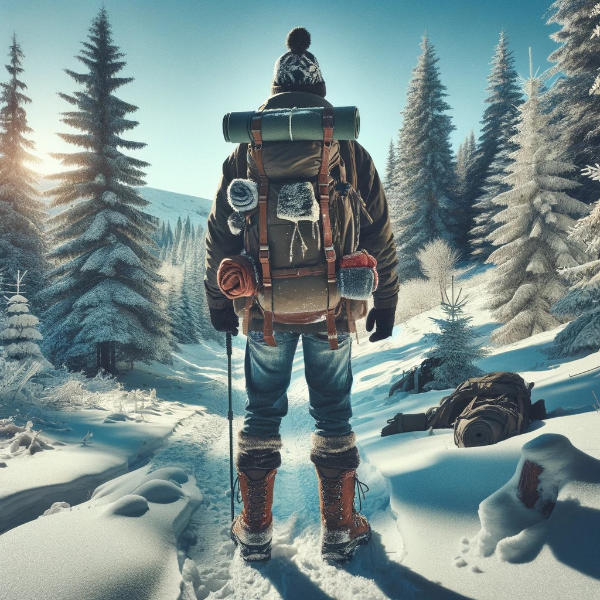
Cold weather hiking isn’t just a walk in the park – unless that park is blanketed in snow, kissed by frost, and frequented by more deer than people. Picture this: a tranquil world where snowflakes dance around you and every breath turns to misty magic in the crisp air. But don’t let the winter wonderland fool you; this is a realm where challenge and beauty walk hand in hand. Our guide is your ticket to mastering the art of hiking in Jack Frost’s backyard, where every step is a mix of caution and thrill. So, lace up those boots, and let’s venture into the frosty heart of cold weather hiking – where every snow-covered path leads to adventure!
Risks of Cold Weather Hiking

When embarking on a cold weather hiking adventure, understanding and respecting the risks associated with the colder climate is essential. This section delves into the primary concerns every winter hiker should be aware of: hypothermia, frostbite, dehydration, and altitude sickness. Awareness and preparation are key to safely enjoying the winter wilderness.
Hypothermia: Causes, Symptoms, and Prevention
Hypothermia occurs when your body loses heat faster than it can generate it, leading to a dangerously low body temperature. It’s a common risk in cold weather hiking, especially when hikers are inadequately dressed or encounter unexpected weather changes.
- Causes: Hypothermia can be triggered by prolonged exposure to cold temperatures, wet conditions, or strong winds. It can occur even at temperatures above freezing, particularly if a hiker becomes wet.
- Symptoms: Early signs include uncontrollable shivering, fatigue, and loss of coordination. As it progresses, symptoms worsen to include slurred speech, confusion, and drowsiness. In severe cases, shivering stops, which is a sign of critical danger.
- Prevention: The best way to prevent hypothermia is to stay warm and dry. Layering appropriately, avoiding cotton (which retains moisture), and using waterproof gear is crucial. Also, monitor yourself and your hiking companions for signs of hypothermia and be prepared to take immediate action, such as adding layers, increasing physical activity, or finding shelter.
Frostbite: Identification and Protective Measures
Frostbite is the freezing of skin and underlying tissues, usually affecting the extremities like fingers, toes, ears, and nose. It can occur rapidly in freezing conditions, especially when the skin is exposed to cold air or comes into contact with cold surfaces.
- Identification: The initial phase of frostbite is often marked by a ‘pins and needles’ sensation, followed by numbness. The skin may appear waxy, hard, and pale. As frostbite progresses, it leads to a complete loss of sensation and the formation of blisters after rewarming.
- Protective Measures: To prevent frostbite, keep your extremities warm and dry. Wear insulated gloves, thick socks, a hat, and a face mask if necessary. Limit skin exposure to cold air and avoid touching cold metal with bare skin. It’s also essential to periodically check for signs of frostbite, especially in very low temperatures.
Dehydration in Cold Weather
Dehydration is a frequently underestimated risk during cold weather hikes. Because the air is drier and colder, you may not feel thirsty, but your body is still losing water through respiration and sweat.
- Misconceptions: Many hikers believe they need to drink less in cold weather, but your hydration needs do not decrease significantly.
- Realities: To stay adequately hydrated, carry a sufficient water supply and drink regularly throughout your hike. Insulated water bottles or hydration systems are recommended to prevent freezing. Additionally, eating snow is not advised as a hydration method, as it lowers your body temperature and requires more energy to melt.
Altitude Sickness in Cold Environments
Altitude sickness, or acute mountain sickness (AMS), can be exacerbated in cold weather. The combination of higher altitudes and lower temperatures can accelerate the onset of symptoms.
- Awareness: Symptoms include headache, nausea, dizziness, and fatigue. If you plan to hike at high altitudes, acclimatize properly by gradually increasing elevation.
- Precautions: Stay hydrated, avoid overexertion, and listen to your body. If symptoms worsen, descend to a lower altitude immediately and seek medical attention if necessary.
By understanding these risks and preparing accordingly, hikers can safely enjoy the unique challenges and rewards of cold weather hiking. Remember, the key to a successful winter hike lies in respecting the elements and knowing your limits.
Planning Your Hike

Proper planning is crucial for any hiking trip, but it becomes even more critical when dealing with the challenges of cold weather. This section covers essential aspects of planning your hike to ensure safety and enjoyment in the winter wilderness.
Selecting the Right Trail
Choosing an appropriate trail for winter hiking requires careful consideration. Factors like trail difficulty, terrain type, and the trail’s history of winter conditions should be taken into account.
- Trail Difficulty: Consider your experience and fitness level. Winter conditions can make even familiar trails significantly more challenging.
- Terrain Type: Be aware of the terrain’s nature – flat, hilly, or mountainous. Each presents different challenges in winter, such as increased risk of avalanches on steeper slopes.
- Winter Conditions: Research the trail’s winter conditions. Some trails may be closed or have restricted access during winter months. Information can often be found through local hiking clubs or national park websites.
Checking Weather Conditions
Winter weather can be unpredictable and change rapidly. Always check the weather forecast before heading out.
- Short-Term Forecasts: Look at the immediate weather predictions for the day of your hike. Be prepared for sudden changes, such as unexpected snowfall or temperature drops.
- Long-Term Trends: Be aware of general weather trends in the area. This can include the likelihood of storms, prevailing wind directions, and typical temperature ranges.
Timing Your Hike
Daylight hours are significantly shorter in winter, and it’s essential to plan your hike accordingly.
- Start Early: Begin your hike early to maximize daylight hours. Remember that the sun sets earlier in winter, reducing your available hiking time.
- Plan for Shorter Distances: Due to slower progress in snow and the need for additional breaks, plan for shorter distances than you would in warmer weather.
- Emergency Buffer: Always include a time buffer for unexpected delays or emergencies.
Emergency Planning
Always prepare for the unexpected. Letting someone know your hiking plan can be a lifesaver in emergencies.
- Inform Someone: Always inform someone reliable about your hiking plan, including your intended route and expected return time.
- Emergency Contact: Provide the contact details of local emergency services to your emergency contact person.
- Plan B: Have an alternative plan in case of unexpected trail closures or severe weather conditions. This might include an alternative route or a decision to postpone the hike.
By thoroughly planning your hike, and considering the trail conditions, weather, timing, and emergency scenarios, you are setting yourself up for a safer and more enjoyable cold weather hiking experience. Remember, in winter hiking, being over-prepared is always better than being under-prepared.
Gear Essentials for Cold Weather Hiking

Equipping yourself with the right gear is a fundamental part of cold weather hiking. This section outlines the essential gear needed to tackle the challenges of hiking in cold, snowy conditions. Having the right equipment not only enhances your safety but also increases your enjoyment of the experience.
Layering for Cold Weather
Layering is a critical strategy for regulating body temperature and staying dry during cold weather hiking. The layering system typically consists of three main types: base layer, insulation layer, and outer layer.
- Base Layer: The base layer sits next to your skin and should be made of moisture-wicking material, like merino wool or synthetic fabrics, to keep sweat away from your body.
- Insulation Layer: This layer retains body heat to protect you from the cold. Fleece or down jackets are popular choices, providing warmth without excessive bulk.
- Outer Layer: The outermost layer should be waterproof and windproof to protect against snow, rain, and wind. Look for breathable fabrics to prevent overheating and moisture buildup.
Footwear: Choosing Boots and Traction Aids
Proper footwear is vital for maintaining comfort and preventing injuries.
- Winter Hiking Boots: Choose insulated, waterproof boots with a high ankle to keep your feet warm and dry. Good grip and support are crucial for slippery and uneven terrain.
- Traction Aids: In icy conditions, traction devices like crampons or microspikes can be attached to your boots to prevent slips and falls.
Backpack Essentials
Packing the right items in your backpack can mean the difference between a successful hike and a potentially dangerous situation.
- Emergency Kit: Include a first-aid kit, multi-tool, flashlight or headlamp (with extra batteries), and a fire-starting kit.
- Food and Hydration: Pack high-energy, easily consumable foods. Carry water in insulated bottles or hydration systems to prevent freezing. Consider carrying a water filtration device.
- Navigation Tools: Even if you plan to use a GPS device, always carry a map and compass as backups.
- Extra Clothing: Pack extra base layers, socks, and insulation layers in case you get wet or conditions are colder than anticipated.
Navigation Tools: GPS, Maps, and Compass in a Winter Setting
Navigation can be more challenging during cold weather hikes due to snow-covered trails and shorter daylight hours.
- GPS Device: A GPS can be a useful tool for navigating trails in winter. Ensure it’s fully charged and consider carrying a power bank.
- Maps and Compass: Always carry a physical map and compass as a reliable backup to electronic devices. Familiarize yourself with their use before your hike.
By carefully selecting and packing your gear, you can ensure that you’re well-equipped for the unique challenges of cold weather hiking. Remember, in winter conditions, it’s better to have and not need than to need and not have.
Navigational Challenges
Navigational skills are crucial in any hiking scenario, but they become even more critical during cold weather hiking. Winter conditions can drastically alter the landscape, making familiar trails seem unrecognizable and increasing the likelihood of getting lost. This section covers the unique challenges you might face while navigating in a winter environment and how to prepare for them.
Winter Trail Finding
Snow-covered trails can obscure familiar landmarks and trail markers, making navigation tricky. Here’s how to stay on track:
- Look for Cues: Pay attention to subtle signs like trail indentations, marker poles, or cairns (stacks of rocks used as markers).
- Use GPS Wisely: While a GPS can be helpful, don’t rely on it solely. Batteries can drain quickly in cold weather, and devices can fail.
- Stay Aware: Regularly check your position against a map to ensure you’re on the right path.
Using a GPS in Cold Weather
GPS devices are valuable tools for winter hiking, but cold weather can affect their performance.
- Battery Life: Cold temperatures can drain batteries rapidly. Carry spare batteries and keep them warm, possibly close to your body.
- Reliability: Remember that GPS signals can be less reliable in dense forests or deep valleys. Always have a backup navigation method.
- Pre-Trip Preparation: Before your hike, load your GPS with the necessary maps and waypoints. Familiarize yourself with the route.
Importance of a Physical Map and Compass
In the digital age, traditional navigation tools like maps and compasses might seem outdated, but they are invaluable, especially in cold weather conditions.
- Reliability: Unlike electronic devices, a map and compass don’t rely on batteries or signals, making them reliable tools in all conditions.
- Skills: Develop the necessary skills to use these tools effectively. Knowing how to read a topographic map and use a compass for orientation is crucial.
- Preparation: Study the map of your hiking area beforehand. Identify key landmarks, trail junctions, and potentially challenging areas.
Navigational challenges are a significant aspect of cold weather hiking. Being prepared with the right tools and skills can ensure a safe and enjoyable experience. Remember, in winter hiking, your navigation skills are as important as your physical ability to trek through the snow.
Nutrition and Hydration

Proper nutrition and hydration are key components of any hiking trip, but they take on extra importance during cold weather hiking. The cold environment and the physical exertion of moving through snow and challenging terrain increase your body’s energy and hydration needs. This section focuses on how to meet these needs effectively.
Dietary Needs for Cold Weather Hiking
Your body burns more calories in cold weather to maintain body heat and energy levels, making it essential to plan your meals and snacks carefully.
- Increased Caloric Intake: Pack foods that are high in calories and easy to eat on the go. Nuts, dried fruits, chocolate, and energy bars are excellent choices.
- Warm Meals: If possible, include a means to heat food. Hot meals like soups or pasta not only provide necessary nourishment but also help to keep you warm.
- Easy-to-Eat Foods: In cold temperatures, your body may not feel as hungry. Choose foods that are appealing and easy to consume, even when you’re not feeling hungry.
Hydration Strategies
Staying hydrated is crucial, but it can be challenging in cold weather as your body’s thirst response is diminished, and water sources may be frozen.
- Prevent Freezing: Use insulated water bottles or hydration bladders. Store them in an accessible place so you can drink easily without having to stop and remove your backpack.
- Warm Liquids: Carry a thermos with a hot drink like herbal tea. This helps maintain your core temperature and makes drinking more appealing in cold weather.
- Regular Intake: Drink water at regular intervals, not just when you feel thirsty. Dehydration can be insidious and impact your energy levels and cognitive functions.
By prioritizing your nutritional needs and ensuring adequate hydration, you can maintain high energy levels and enjoy a safe and satisfying cold weather hiking experience. Remember, in the challenging conditions of winter hiking, your body’s demand for energy and hydration is significantly increased.
Establishing a Safe Pace
One of the critical aspects of cold weather hiking is setting and maintaining a pace that is safe and sustainable. Unlike hiking in warmer conditions, winter hiking presents unique challenges such as navigating through snow, dealing with harsh weather conditions, and managing energy levels. This section will explore how to establish a pace that ensures safety, conserves energy, and allows for an enjoyable hiking experience.
Adjusting Hiking Pace to Conserve Energy and Maintain Warmth
In cold weather conditions, your body expends more energy to keep warm. It’s crucial to find a balance between maintaining a pace that keeps you warm without causing excessive sweating, which can lead to chilling.
- Start Slow: Begin your hike at a slower pace to allow your body to warm up without sweating. Adjust as needed based on your comfort.
- Regular Breaks: Take regular, short breaks to check for cold injuries, hydrate, and snack. Long breaks can cause your body to cool down too much.
- Pacing Strategy: Be prepared to adjust your pace based on the terrain. In deep snow or icy conditions, you may need to move more slowly to maintain safety.
Recognizing and Responding to Signs of Exhaustion and Cold-Related Ailments
Being aware of how your body is reacting to the cold and exertion is key in cold weather hiking.
- Monitor Physical Signs: Pay attention to signs of fatigue such as heavy breathing, muscle weakness, or a decline in coordination. These could indicate that it’s time to slow down or take a break.
- Be Aware of Cold-Related Symptoms: Keep an eye out for symptoms of frostbite and hypothermia. If you or a hiking partner shows signs of these conditions, it’s crucial to take immediate action, like adding layers or finding shelter.
Group Pacing
If hiking in a group, it’s important to set a pace that is comfortable for all members.
- Stay Together: Ensure that the pace is suitable for the slowest member of the group. It’s safer and more enjoyable when the group stays together.
- Regular Communication: Check in with each other frequently to ensure that everyone is comfortable with the pace and not struggling with the cold or fatigue.
By establishing a safe and sustainable pace, hikers can enjoy the beauty and solitude of cold weather hiking without compromising their safety or well-being. Remember, the key to a successful winter hike is to listen to your body and be flexible with your pacing strategy.
Wildlife Considerations

Wildlife encounters can be a memorable part of any hiking experience, including cold weather hiking. However, the winter environment brings its own set of challenges and considerations when it comes to wildlife. This section outlines important aspects to be aware of regarding wildlife during your cold weather hiking adventures.
Understanding Winter Wildlife Behavior
Animals behave differently in the winter, and understanding these changes is key to a safe and respectful hiking experience.
- Reduced Visibility: Many animals have adapted to blend into the snowy environment, making them harder to spot. Stay observant to avoid startling wildlife.
- Altered Habits: Some animals may be more active during the day in winter months to conserve energy. Be aware of tracks or signs of wildlife and know what animals are native to the area you’re hiking in.
- Food Scarcity: Food sources are scarcer in winter, so animals might be drawn to anything that smells like food. Secure your food properly to avoid attracting wildlife to your campsite.
Safety Measures for Encountering Wildlife in Cold Weather
Encountering wildlife in cold conditions requires a cautious approach to ensure the safety of both the hikers and the animals.
- Keep Your Distance: Always maintain a safe distance from wildlife. Avoid approaching or feeding them, as this can be dangerous and disrupt their natural behavior.
- Stay Calm: If you encounter wildlife, stay calm and do not make sudden movements. Back away slowly if the animal seems disturbed.
- Group Safety: If hiking in a group, stay together. There is safety in numbers, and animals are less likely to approach a group.
Protecting Wildlife Habitats
Respecting the natural habitats of wildlife is crucial, especially in winter when they are more vulnerable.
- Stay on Trails: To minimize your impact on the environment and wildlife, stay on designated trails. Venturing off-trail can damage habitats and disturb animals in their natural settings.
- Noise Levels: Keep noise to a minimum. Loud noises can startle and stress wildlife, especially in the quieter winter months.
By understanding and respecting wildlife and their habitats, hikers can safely enjoy the unique experiences that cold weather hiking offers, while also preserving the natural environment for future generations. Remember, a key aspect of responsible hiking is being a good steward of the wilderness and its inhabitants.
Training and Physical Preparation
Cold weather hiking demands not only appropriate gear and knowledge but also a certain level of physical fitness and skills. This section focuses on the training and preparation necessary to safely enjoy cold weather hiking.
Importance of Physical Fitness for Cold Weather Hiking
The physical demands of hiking in cold and snowy conditions are significantly higher than in milder climates. Good physical fitness enhances your ability to handle these demands.
- Cardiovascular Fitness: Regular cardiovascular exercise improves endurance, crucial for long hikes in challenging winter terrain.
- Strength Training: Focus on building leg strength and core stability. This helps in navigating through snow and carrying a heavier winter pack.
- Balance and Flexibility: Activities like yoga or balance exercises help improve your stability on uneven and slippery surfaces, reducing the risk of falls.
Skills Training: First Aid, Navigation, and Cold-Weather Survival Skills
Being skilled in various aspects of hiking safety is as important as being physically fit. These skills can be lifesaving in emergencies.
- First Aid Training: Knowing how to handle medical emergencies, particularly those common in cold weather like frostbite and hypothermia, is essential.
- Navigation Skills: Proficiency in using a map and compass, as well as understanding how to navigate in snowy conditions where trails are not visible, is crucial.
- Cold-Weather Survival Skills: Skills such as building a shelter, starting a fire in snowy conditions, and understanding how to stay warm and dry can be critical in a survival situation.
3. Pre-Hike Conditioning and Acclimatization
Preparing your body for the specific challenges of cold weather hiking is important for both safety and enjoyment.
- Hiking Practice: Engage in shorter hikes to condition your body, especially if carrying a heavier pack than you’re used to.
- Acclimatization: If your hike will be at a higher altitude, spend time at increasing elevations leading up to your hike to allow your body to adjust to the lower oxygen levels.
By focusing on physical fitness, skill development, and proper conditioning, you can significantly enhance your cold weather hiking experience. Remember, the better prepared you are, the more you’ll enjoy the unique challenges and beauty of hiking in a winter wonderland.
Conclusion
As we conclude our comprehensive guide to cold weather hiking, it’s important to reflect on the key themes we’ve explored. From understanding the risks to mastering the art of layering, from honing your navigational skills to respecting the wildlife, each aspect plays a vital role in ensuring a safe, enjoyable, and sustainable hiking experience in the colder months.
Remember, cold weather hiking offers an opportunity to witness nature’s quiet beauty in its most serene state. The stillness of a snow-covered landscape, the crispness of the winter air, and the unique challenges of the terrain provide a refreshing perspective on the great outdoors.
However, this beauty comes with its own set of challenges. Preparation is key. Equip yourself with the right gear, train your body and mind, plan your route carefully, and always respect the environment and its inhabitants. Whether you’re a seasoned winter hiker or a first-timer, understanding and preparing for the demands of cold weather hiking is crucial.
As you embark on your winter hiking adventures, carry with you not just the essentials for survival, but also a sense of responsibility and a deep appreciation for the natural world. Let each step be a reminder of the resilience and adaptability required not just in hiking, but in life. And above all, let the journey through the winter wilderness inspire and rejuvenate you.
We have many more hiking and outdoor articles that may interest you on our Hiking Blog.
FAQs
Cold Weather Hiking FAQ
Q: What temperature is too cold for hiking?
A: The threshold for “too cold” varies depending on individual tolerance, experience, and preparedness. Generally, temperatures below 20°F (-6°C) are considered extremely challenging and potentially hazardous for hiking. However, with proper gear and preparation, experienced hikers can safely hike in these colder temperatures.
Q: How do you hike in 30-degree weather?
A: Hiking in 30°F (-1°C) weather requires proper layering (base, mid, and outer layers), insulated waterproof boots, and accessories like hats, gloves, and scarves. Adjust layers as needed to avoid sweating, and stay hydrated.
Q: Is it harder to hike in cold weather?
A: Yes, hiking in cold weather can be more challenging due to factors like slippery or snow-covered trails, heavier clothing and gear, and the body’s increased energy expenditure to stay warm.
Q: Is it okay to go hiking with a cold?
A: It’s generally advised to avoid strenuous activities like hiking if you have a cold, as it can exacerbate your symptoms and reduce your body’s ability to stay warm, increasing the risk of hypothermia.
Q: Is it too cold to walk in 30-degree weather?
A: Walking at 30°F (-1°C) is not too cold if you dress appropriately. Layering, covering exposed skin, and protecting extremities are crucial to stay warm and comfortable.
Q: Is 20 degrees too cold to walk?
A: Walking at 20°F (-6°C) is possible with proper clothing and gear, such as insulated layers, hats, gloves, and winter boots. It’s important to monitor your body’s response to the cold and take breaks as needed.
Q: What is the best fabric for hiking in cold weather?
A: The best fabrics for cold weather hiking are moisture-wicking materials like merino wool or synthetic fibers for base layers, and insulating materials like fleece or down for mid-layers. The outer layer should be waterproof and windproof.
Q: What do you wear when hiking in the winter?
A: Winter hiking attire includes thermal base layers, an insulating mid-layer (like a fleece or down jacket), and a waterproof, windproof outer layer. Also, wear insulated waterproof boots, gloves, a hat, and a neck gaiter or scarf.
Q: What do you wear hiking in 30-degree weather?
A: In 30°F (-1°C) weather, wear a moisture-wicking base layer, an insulating layer (like fleece), and a waterproof outer layer. Complete your outfit with a hat, gloves, and insulated waterproof boots.
Q: How do you layer hiking in cold weather?
A: Layering for cold weather hiking involves three main layers: a moisture-wicking base layer, an insulating mid-layer (fleece or down), and a waterproof, windproof outer shell. Adjust layers based on your activity level and weather conditions.
Q: What food is good for hiking in the cold?
A: High-energy, easily digestible foods are good for cold weather hiking. Opt for nuts, dried fruits, energy bars, chocolate, and hot, easily prepared meals like soups or pasta.
Q: What is non-perishable food for hiking?
A: Non-perishable foods for hiking include nuts, seeds, dried fruits, energy bars, jerky, and dehydrated meals. These items are lightweight, nutrient-dense, and don’t require refrigeration.
Q: What foods are good for long hikes?
A: For long hikes, bring foods that are high in energy and easy to eat. This includes trail mix, nuts, energy bars, fruit leathers, sandwiches, and if possible, complex carbohydrates like pasta or rice dishes.
Q: What is the best food to take hiking overnight?
A: For overnight hiking, pack a combination of high-energy snacks (like nuts and energy bars) and fulfilling meals (like dehydrated meals or easy-to-cook pasta). Also, consider foods that can be eaten without cooking in case of equipment failure.